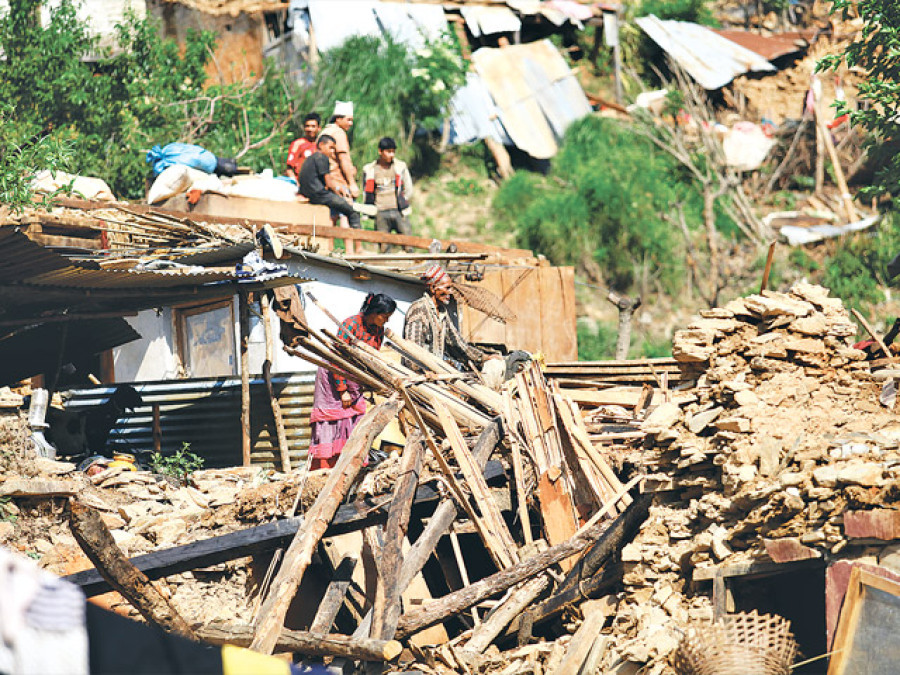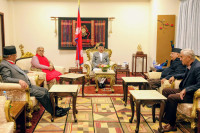Opinion
Learning from Gujarat
There are lessons for Nepal from sustainable, community-based reconstruction practices in Gujarat after the 2001 earthquake
Sachchi Ghimire Karki
Disasters, with all their tragic outcomes, also embody the opportunity to develop as the post-disaster response can be made to better relate to development.
The earthquake in Nepal on 25 April has so far claimed over 6,000 lives, left thousands injured, razed villages, cities, infrastructure, and cultural and historic sites. The government estimates that 130,033 houses have been destroyed and 85,856 are partially damaged. As post-quake relief activities continue, I will attempts to share some of the best practices from Gujrat’s successful post-quake recovery, particularly the physical reconstruction of Gujarati dwellings.
The similarity of the context of the recent Nepal earthquake with the 2001 Gujarat quake is to be noted. The 7.7 magnitude earthquake that hit Gujarat lasted 80 seconds and claimed 20,000 lives and injured 600,000 people. Studies are unanimous in asserting that the death toll was compounded by the poor construction of buildings, including public buildings. In the quake, health facilities in Gujarat also collapsed, aggravating the post-quake situation as the injured were deprived of emergency care. In rural areas, where the impact was most damaging, the poor construction quality of houses took the major share of the blame.
Public-private partnership with affected communities at the centre of all decision-making processes regarding physical reconstruction of their communities was most important for post-quake rehabilitation in Gujarat. Involvement, leadership, and ownership of the community in the post-disaster recovery process can be instrumental in building capacity and confidence. In Gujarat, rehabilitation became part of a development incentive, with sustainability built in through intense participation of community members at all stages of reconstruction.
A disaster-resilient community
Gujarat’s reconstruction was primarily led by the government of the state, under the Gujarat Emergency Earthquake Reconstruction Project (GEERP), with assistance from national and international actors and private sector. The bulk of the funding for housing was provided by the World Bank. The Asian Development Bank (ADB), in partnership with NGOs and the government of Gujarat, led rural housing reconstruction. Additionally, the UN and other bilateral donors came forth with assistance.
ADB-funded houses were constructed in a public-private partnership with multi-hazard resistant technology after extensive consultations with beneficiaries. Over 29,600 masons and 6,500 engineers were trained in multi-hazard resistant housing construction and reconstruction. In the Nepal context, agencies working on disaster risk reduction, including UNDP, have already invested in training masons and engineers on constructing disaster resilient structures. These trained people need to be sought out and used to train masons in different districts and localities as the reconstruction starts. This will ensure community ownership of the process while ensuring the safe reconstruction of their dwellings and public buildings.
For their outstanding work in the field of disaster management and risk reduction, in 2003, the Gujarat State Disaster Management Authority (GSDMA) was awarded the prestigious UN Sasakawa awards. There may be lessons for the Government of Nepal in the GSDMA.
Community values
The Kobe Action Plan 2003 maintains that in earthquakes, affected individuals and their neighbours are the best disaster managers. Post-disaster rehabilitation should focus on the needs of communities. Scholars concur that locally-calibrated implementation technologies will ensure a more disaster-resilient community.
In Gujarat, reconstruction encouraged community participation in three major ways. Community members were invited during discussions of the designs of the village, dwelling, and community building layouts. Training on how to incorporate seismic safety into traditional construction techniques were also provided. The reconstruction reflected traditional aesthetics.
Additionally massive information, education, and communication programmes were undertaken to educate people about the reconstruction effort. To provide further security, all new houses were registered jointly in the name of the husband and the wife and were insured against 14 types of natural and manmade disasters. Along with a strong sense of ownership, such consultation, trainings, and rules were instrumental in developing disaster preparedness.
Community participation and involvement in the reconstruction process in Gujarat not only gave survivors a sense of ownership of the houses and communities that were being reconstructed, but also provided them with a sense of purpose to ease their minds in the aftermath of the disaster. Applied to the Nepal case, this will likely bear the same outcomes.
Coordinating assistance
Media footage of crisis situations often propel humanitarians—volunteers as well as organisations—towards the crisis zone. But often, poor planning, compounded by the overwhelming situation, lack of capacity to absorb resources, and technical expertise by the affected country—mars their impact. Proper planning therefore is indispensable. Post disaster needs are contextual. For example, one earthquake survivor in Nepal was heard saying, “Six days after the disaster, we have survived under tents made up of locally-available sacks and plastic. If relief providers now come with tarpaulins, we will have no use of them. Our needs are different.” Whereas in Bhaktapur, survivors are demanding tents. This is emblematic of how local needs may actually be different from the estimates of well-intentioned support providers.
Therefore, post disaster recovery should be locally led, as locals know what the community needs and what can or has been locally resolved. In the immediate aftermath of the disaster, countries like Nepal are often overwhelmed by the dearth of resources and the magnitude of the needs. In such circumstances, proper communication and coordination prior to the dispatch of technical and physical support will be necessary.
Also necessary will be the specialisation of the assistance provided, based on the providers’ previous experience. For example, while large-scale rescue and relief has been led by government(s) and experts from the army, police, paramilitary (all national as well as international), and local volunteers, other organisations can focus on other areas of need. For example, those involved in the sustainable reconstruction of Gujarati villages may have great technical experience to bring to Nepal. Currently, in Nepal, the Japan International Cooperation Agency (Jica) is taking the lead in the collection and sorting of artefacts from the rubble in Basantapur and elsewhere. Specialised assistance in that area would be very useful.
The government needs to be strategic in requesting assistance from various interested governments and organisations so that relief can be initiated in the multiple areas where we have suffered losses. In doing so, they will need to be in constant communication with local actors and also understand the assistance providers’ comparative advantage and strategically link the two. Coordination will continue to remain key. In the absence of coordination, duplication and resource leakages may render resources and support futile. Also of pivotal importance here is the timing and sequencing of activities. All of this needs to be done urgently and cannot wait until the next calendar week or month.
In providing such relief, coordinating with and building the capacity of groups of young people with widespread networks, like the Association of Youths of Nepal (AYON) and Bibeksheel Nepali, among others, will be very useful, as that will ensure the sustainability of knowledge transfer and will keep youths constructively engaged.
Post disaster recovery support needs to merge with long-term development goals. Deep engagement with the community, local actors, and the youth are therefore key to ensuring the sustainability of efforts and the concretisation of development gains.
Ghimire Karki was a Fulbright Scholar in International Human Rights at the University of Denver, the US




 8.12°C Kathmandu
8.12°C Kathmandu











